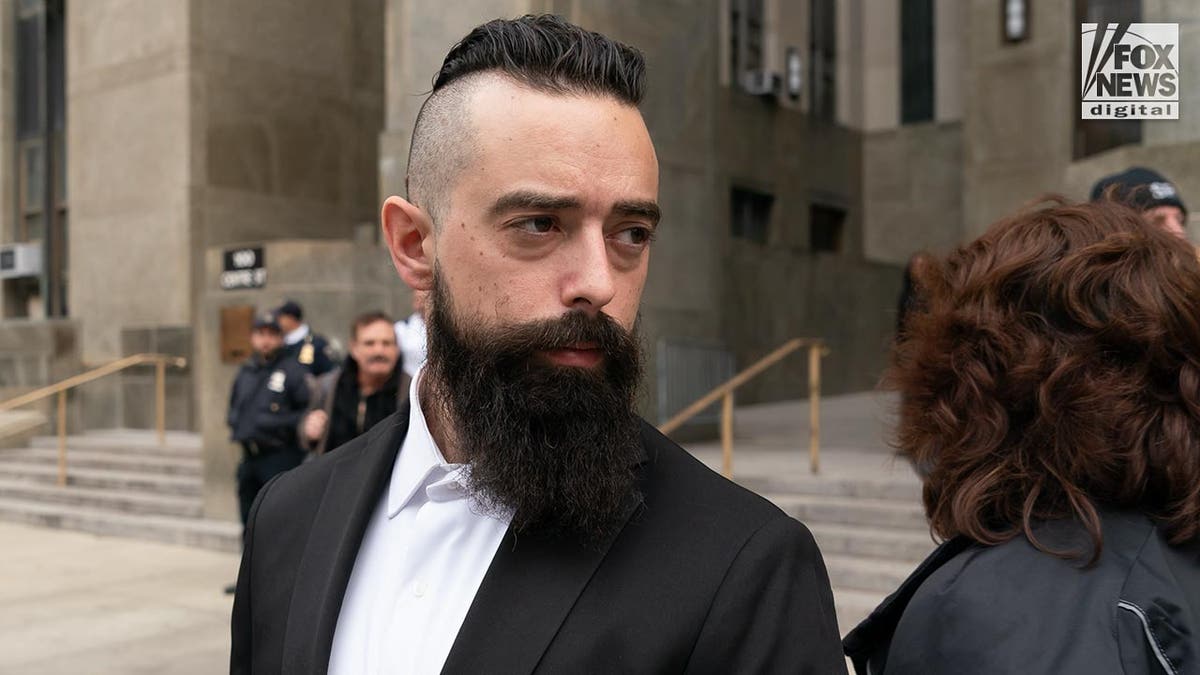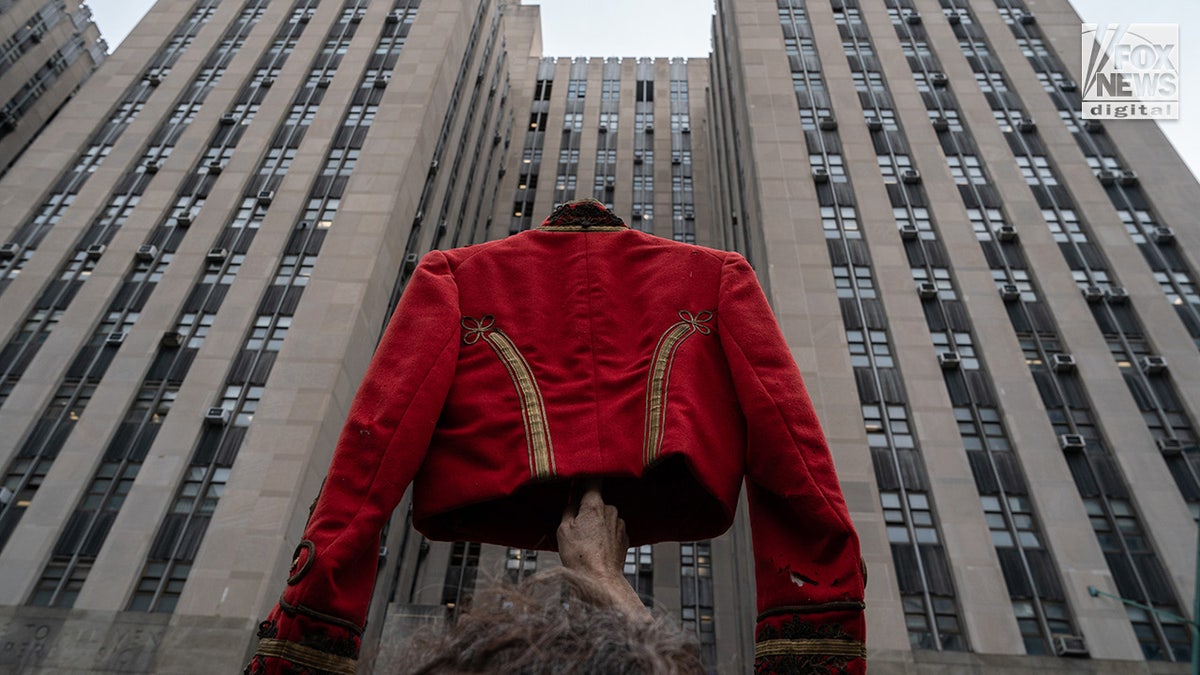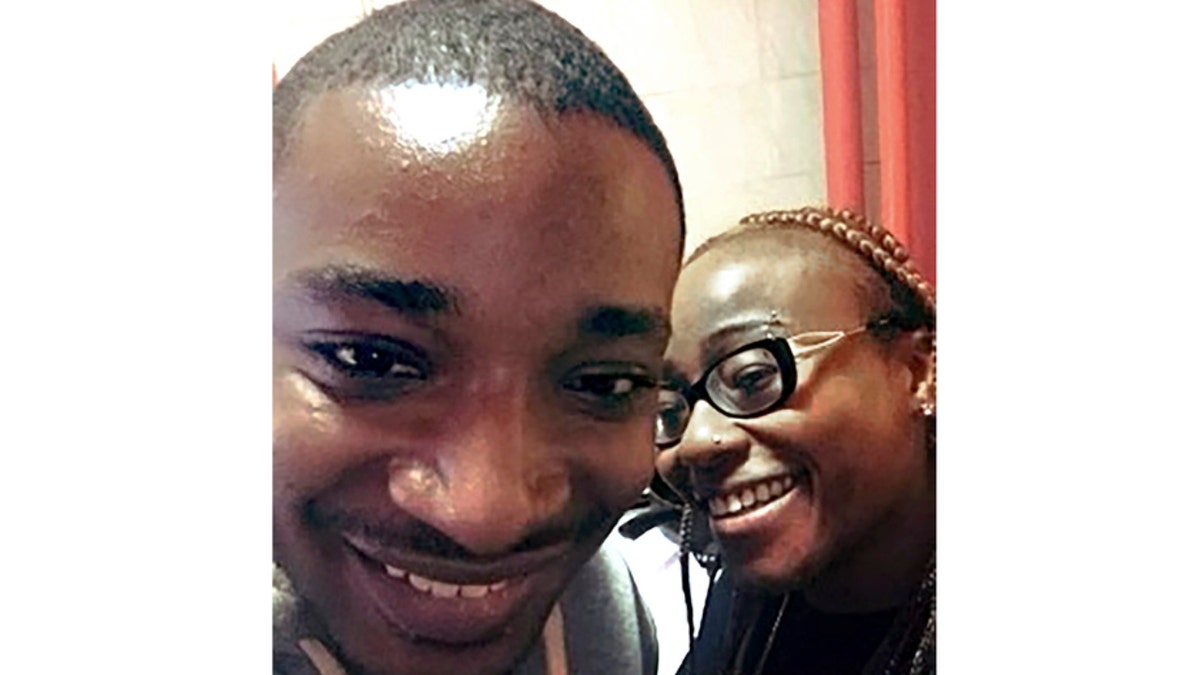Northeast
Medical examiner says subway madman had drugs in system in Marine vet’s chokehold trial

NEW YORK CITY – The prosecution is expected to rest on Monday in the trial of Daniel Penny, who is charged with manslaughter in the New York City subway death of Jordan Neely.
Penny’s defense will then get underway. On Monday morning the 26-year-old Marine veteran’s team was expected to continue cross-examining Dr. Cynthia Harris of the City Medical Examiner’s Office, who began testifying last week.
Harris, who conducted the autopsy on Neely after he died following an aggressive outburst on a subway car, testified Friday that Neely had synthetic drugs in his system when he died but had been killed by asphyxiation.
The Manhattan forensic pathologist said she had ruled the 30-year-old Neely’s cause of death to have been asphyxia from compression to his neck. The toxicology report showed he also had drugs in his system, although she said she could identify them broadly as “a synthetic cannabinoid,” but not in specific terms or at what dose.
“We found in the blood a synthetic cannabinoid – a relatively new drug in the scheme of drugs,” she said. “They’re synthetic and more potent than marijuana. In a class of drugs, they fall under the category of stimulants – they rev the body up, fall into the same class of drugs as, say, cocaine.”
DANIEL PENNY TRIAL RESUMES AS FELLOW MARINE VET EXPLAINS CHOKEHOLD TRAINING ON WITNESS STAND
Daniel Penny arrives for his trial at the Manhattan Criminal Court building in New York City on Friday, Nov. 15, 2024. Penny, a Marine veteran, is charged with second-degree manslaughter and criminally negligent homicide in the 2023 death of Jordan Neely on a New York City subway train. (Adam Gray for Fox News Digital)
There was no damage to bones in his chin, neck or midline structures, she said. She found scrapes and bruises on his face, neck, torso and arms, petechiae (small red spots caused by bleeding) in his eyes and damage to his spleen from sickle cell trait.
Prosecutors played video of the chokehold again and Dr. Harris commented as she went through it.
At one point, she said he was conversing, showing that he had “air moving through his vocal chords.” She described Neely straining to breathe and making hand gestures, which she said were a signal for help.
Assistant District Attorney Dafna Yoran asked about witnesses testifying that Neely hadn’t gagged or gasped or said that he couldn’t breathe.
“Sometimes people make noises when they can’t breathe, and sometimes they don’t,” she replied.

Cynthia Harris, M.D. arrives for Daniel Penny’s trial at the Manhattan Criminal Court building in New York City on Friday, Nov. 15, 2024. Penny, a Marine veteran, is charged with second-degree manslaughter and criminally negligent homicide in the 2023 death of Jordan Neely on a New York City subway train. (Adam Gray for Fox News Digital)
She also said that she believes that Neely died around two minutes, nine seconds into the video, after his face turned purple and he began “twitching” in death throes.
“I believe that at this point he has lost consciousness, and what we will see in the form of these twitchings represents brain injury,” she said.
Under cross-examination she later said she couldn’t tell his time of death from the video.
“I can’t tell you when exactly he died, philosophically, but the video is of a man dying,” she said.
Penny is on trial for the May 1, 2023, death of Neely, a homeless man with a lengthy criminal record and history of mental illness who stormed onto the train and started making death threats, according to witnesses.
As he screamed about going to prison for life, raised his fists and lunged at people, Penny grabbed him in a headlock and wrestled him to the ground. Other riders helped hold him down as they waited for police to arrive. Neely died.
Dr. Harris’ testimony began Thursday, after Joseph Caballer, the Marine martial arts instructor who had taught Penny about chokeholds, told the jury that the point of the maneuver is to take control of a threat until they are unconscious.
Caballer explained the difference between blood chokes and air chokes – moves that alternately deprive the aggressor of bloodflow to and from the brain or oxygen. Dr. Harris described on Friday what she had seen in the video.

Joseph Caballer exits Manhattan Supreme Court in New York City on Thursday, Nov. 14, 2024. The 30-year-old former Marine testified at the trial of Daniel Penny in the chokehold death of Jordan Neely on a New York City subway in May 2023. (Adam Gray for Fox News Digital)
“If you only compress the vein, but you have not applied enough force to compress the artery, there are a few things you see when that happens,” she said. “You become congested or purple in color. The veins become distended, because they’re full of blood. If the pressure continues, then the capillaries develop pools of blood or petechiae.”
She had the ADA stop the video and said that she sees that the veins in Neely’s face are distended and his face appears purple, much darker than the skin on his arms.
Under cross examination from Penny defense attorney, Steven Raiser, Dr. Harris said acknowledged that a colleague found the petechiae to be small and “not conclusive.” She agreed that it would be fair to say that the small petechiae isn’t a direct sign that death was caused by a chokehold.
The initial finding on May 2, 2023, was that the cause of death was “pending further study.” Then she made a decision after seeing the chokehold video, she said.
“I based my decision on the autopsy findings coupled with the video,” she said. “I didn’t wait for toxicology, because no toxicological report would change my opinion. He could have come back with enough fentanyl to kill an elephant and walked onto the train and got put in a chokehold, and that’s how he died.”
DANIEL PENNY THOUGHT HE WAS PROTECTING A DIVERSE SUBWAY CAR, BUT PROSECUTORS HIGHLIGHT RACIAL UNDERTONES

Demonstrators hold up a Michael Jackson-style jacket to represent Jordan Neely at the Manhattan Criminal Court building in New York City on Friday, Nov. 15, 2024. Daniel Penny, a Marine veteran, is charged with second-degree manslaughter and criminally negligent homicide in the 2023 death of Neely on a New York City subway train. Neely was a former Jackson impersonator. (Adam Gray for Fox News Digital)
Although Neely still had a pulse after Penny let go, Dr. Harris said that wasn’t unusual.
“This is an asphyxial death,” she said. “In an asphyxia death, the brain dies first. It’s deprived of oxygen. Other tissues and organs in the body are not as sensitive as the brain. They too will die, but the brain dies first.”
According to case notes introduced into evidence, Neely’s death was initially suspected to be from cardiac arrest, and he had “no visible trauma.”
During her testimony, Dr. Harris referred to the manner of death as homicide, and the defense objected. The judge ordered those comments stricken from the record.
She also said that the synthetic drugs in Neely’s system “would not help the heart” during a struggle.
Dr. Harris returned Friday morning to pick up where she left off when court adjourned the day before.
The prosecution was expected to rest its case after her testimony. Penny’s defense team are expected to call their first witness Monday – but Dr. Harris will return to the stand for a third day of testimony first.
On Tuesday, a man who appeared on video helping Penny hold Neely down testified.
Eric Gonzales told the court that at one point he said Penny hadn’t held Neely tightly enough, that he had felt a pulse when they both finally let go, that he had been granted immunity from prosecution in exchange for testifying – and that he had initially lied to investigators.

This undated photo, provided by Mills and Edwards, LLP, in New York, Friday, May 12, 2023, shows Jordan Neely, left, with Carolyn Neely, an aunt. (Courtesy Mills & Edwards, LLP via AP)
Penny faces up to 15 years in prison if convicted of the more serious charge of manslaughter.
He also faces a count of criminally negligent homicide.
Read the full article from Here

Boston, MA
Condominium sells in Boston for $4.2 million

A condominium located at 1 Dalton Street in Boston has a new owner. The 1,403-square-foot property, built in 2015, was sold on Oct. 21, 2024, for $4,200,000, or $2,994 per square foot. The layout of this condo includes two bedrooms and three baths. The home’s outer structure has a flat roof frame. The property is equipped with forced air heating and a cooling system. In addition, the home is equipped with a one-car garage, allowing for convenient vehicle storage and protection.
These nearby units have also recently changed hands:
- In July 2024, a 1,693-square-foot unit on Belvidere Street in Boston sold for $2,850,000, a price per square foot of $1,683. The unit has 2 bedrooms and 3 bathrooms.
- On Belvidere Street, Boston, in October 2023, a 972-square-foot unit was sold for $1,400,000, a price per square foot of $1,440. The unit has 1 bedroom and 2 bathrooms.
- A 837-square-foot unit at 100 Belvidere Street in Boston sold in April 2023, for $1,150,000, a price per square foot of $1,374. The unit has 1 bedroom 1 bathroom.
Real Estate Newswire is a service provided by United Robots, which uses machine learning to generate analysis of data from Propmix, an aggregator of national real-estate data. See more Real Estate News
Pittsburg, PA
Pittsburgh Bureau of Emergency Medical Services trying to address staffing issues

PITTSBURGH (KDKA) — Pittsburgh EMS workers say they are understaffed and overstretched, racing from one call to the next.
Like operations throughout the country, the Pittsburgh Bureau of Emergency Medical Services is contending with a shortage of paramedics and emergency medical technicians.
From traffic accidents to people experiencing chest pains to addicts overdosing on fentanyl, the calls for service are constant.
With less than 200 employees, Pittsburgh EMS responded to more than 65,000 calls last year. At the same time, it’s dealing with retirements, on-the-job injuries, and a severe shortage of recruits.
Bureau Chief Amera Gilchrist has stepped up recruiting efforts and employed better use of data, but has had to resort to taking medic units out of service on given days as she tries to provide life-saving services to city residents.
“Any time we have to take units out of service is challenging. I don’t think there has been one call when the public has requested our services when we have not been there,” Chief Gilchrist said.
The men and women of Pittsburgh EMS have been able to maintain that pace despite being severely understaffed. Nationwide, there’s a shortage of EMTs and paramedics recruits, while the city continues to lose them to retirement and injury.
Those on the front lines amassed $6 million in overtime just last year, with one paramedic alone making $327,000. Five others pulled in more than $200,000, while 69 others made more than $100,000 in mostly forced overtime.
“When you’re forced to do overtime and you have a family and you want free time, we don’t wish that on anyone,” says Pittsburgh councilman Anthony Coghill (D).
Managing the staffing shortage and keeping EMS afloat falls to its chief, Gilchrist, who has begun using data to better marshal EMTs to basic calls and the more highly-skilled paramedics to the more serious ones. She’s also taken the controversial step of taking some units out of service on a given day, sidelining one of the medic units in Homewood indefinitely.
At the same time, Gilchrist says she’s trying to address the strain on her employees.
“We care about the mental health of our employees. It has fallen by the wayside in recent years, but that is the reason why we have a hiring and recruitment initiative going on, and it’s going to take time,” Gilchrist added.
This year, Gilchrist has hired 30 additional employees. Some of them are from the Freedom House in the Hill District, named after the original African-American ambulance service which formed the nucleus of EMS Bureau in the early 1970s.
The paramedic union is currently in contract talks with the city, asking for higher base pay and a lifting of the city’s residency requirement, which no longer applies to city police and firefighters.
“Ideally, no, I would not like to see them lift the residency requirement, but if that’s what it takes to get our medic units up to full staff, I’ll let the collective bargaining hash that out,” Coghill said.
Gilchrist believes the EMS will be made whole in time.
“This is a marathon, not a sprint. It didn’t get this way overnight and it’s not going to be fixed overnight, but we are hitting the pavement to get this initiative pushed forward,” Gilchrist said.
Connecticut
Immigration advocates vow to fight Trump deportation plans

Immigration advocates say they’ve already been preparing for President-elect Donald Trump’s pledge to ramp up deportations once he returns to the White House.
“We anticipate that they’re going to be very quick, very rapid, very massive efforts to grab as many people as possible and deport them,” National Immigration Law Center President Kica Matos said during a rally outside the Capitol on Monday.
Matos said hers and other organizations began considering possible actions earlier this year in case Trump won.
Now, Trump is promising to deliver on his campaign pledge, taking to his Truth Social platform earlier in the morning to confirm he plans to declare a national emergency.
He also intends to try and use the military to support his deportation effort, his post confirmed.
Advocates said they’re trying to assume undocumented immigrants in Connecticut that their organizations will offer support.
“If families have to be separated, it defeats the point completely because people are trying to get to the United States to be with their families,” said Tabitha Sookdeo, executive director of CT Students For a Dream.
Sookdeo said her family came from Guyana when she was a teenager and her grandmother, who was a U.S. citizen, was trying to help them also get permanent legal status.
Her grandmother died during the process, though, leaving Sookdeo’s family in limbo.
“Immigration is pretty complicated,” she said.
Democrats, meanwhile, said they won’t support federal deportation efforts.
Attorney General William Tong (D) pointed to the state’s Trust Act, which bars local and state agencies from cooperating with federal immigration enforcement efforts.
“Connecticut is going to care for our immigrant families and immigrant neighbors and friends,” Tong said.
There are some exceptions, including when an undocumented immigrant is convicted of a Class A or Class B felony. Tong wouldn’t say if that means Connecticut has to notify federal authorities of such a conviction.
“I’m not going to issue a legal opinion on the fly from this podium,” Tong said.
Connecticut Republicans were critical of Democrats, though, saying their policies don’t reflect what voters want.
Rep. Vincent Candelora (R-Minority Leader) said Connecticut spends too much money supporting undocumented immigrants, including with Medicaid, education and other assistance.
He also said voters are worried about public safety.
“It’s really out of step, I think, with what the residents and America wants, and that is, you know, safe borders, public safety and we have to get the cost of immigration under control,” Candelora said.
-

 Business1 week ago
Business1 week agoRef needs glasses? Not anymore. Lasik company offers free procedures for referees
-

 News1 week ago
News1 week agoHerbert Smith Freehills to merge with US-based law firm Kramer Levin
-
/cdn.vox-cdn.com/uploads/chorus_asset/file/25724877/Super_Nintendo_World.png)
/cdn.vox-cdn.com/uploads/chorus_asset/file/25724877/Super_Nintendo_World.png) Technology1 week ago
Technology1 week agoThe next Nintendo Direct is all about Super Nintendo World’s Donkey Kong Country
-
Business5 days ago
Column: OpenAI just scored a huge victory in a copyright case … or did it?
-

 Health5 days ago
Health5 days agoBird flu leaves teen in critical condition after country's first reported case
-

 Business2 days ago
Business2 days agoColumn: Molly White's message for journalists going freelance — be ready for the pitfalls
-

 Technology1 week ago
Technology1 week agoHow a researcher hacked ChatGPT's memory to expose a major security flaw
-
Politics1 week ago
Editorial: Abortion was on ballots across the country in this election. The results are encouraging





![LISEN for iPhone 16 MagSafe Car Mount, [Quick Install] Ultra Magnetic Long Arm Mag Safe Car Phone Holder Vent, Car Accessories Fit for iPhone 16 Pro Max 15 14 13 12 Plus Mini Men Women LISEN for iPhone 16 MagSafe Car Mount, [Quick Install] Ultra Magnetic Long Arm Mag Safe Car Phone Holder Vent, Car Accessories Fit for iPhone 16 Pro Max 15 14 13 12 Plus Mini Men Women](https://newspub.live/wp-content/uploads/2024/11/71vWMjFXzeL._AC_SL1500_-80x80.jpg)











